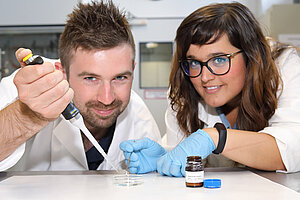A team of researchers from the Max Planck Institute for Chemical Energy Conversion and the <link https: www.kofo.mpg.de de _blank external-link-new-window internal link in current>MPI für Kohlenforschung in Mülheim an der Ruhr have succeeded in optimizing naturally occurring catalysts (hydrogenases) for application.
The new findings mean that the highly oxygen-sensitive enzymes can now also be handled in the air and used in fuel cells or in electrolytic or photolytic water splitting.
This research provides a step forward towards the use of these enzymes in technological applications as well as in understanding the mechanism of inactivation by oxygen. It also provides clues for protecting synthetic molecular catalysts designed for hydrogen conversion and production.
The results were recently published in the Journal of the American Chemical Society:
Patricia Rodríguez-Maciá, Edward J. Reijerse, Maurice van Gastel, Serena DeBeer, Wolfgang Lubitz, Olaf Rüdiger, and James A. Birrell. Sulfide Protects [FeFe] Hydrogenases From O2 J. Am. Chem. Soc. (Just Accepted Manuscript) <link https: pubs.acs.org doi jacs.8b04339 _blank external-link-new-window internal link in current>DOI: 10.1021/jacs.8b04339
You'll find a summary of the work in our <link file:4986 download internal link in current>press release as well.
The publication has also been <link https: www.nature.com articles s41929-018-0137-y _blank external-link-new-window internal link in current>highligted in <link https: www.nature.com natcatal volumes issues _blank external-link-new-window internal link in current>Nature Catalysis.

